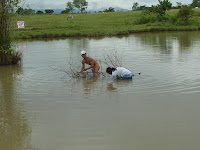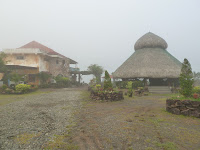On Monday, 26th, the
Philippine Star had a screaming front page headline “CBCP Warns Pro-RH Bets of
Catholic Vote.” The news story cited
Lipa Archbishop Ramon Argueles as the one who made the warning. Such comment of the Archbishop didn’t sit
well with media, some politicians, and even with some bishops themselves. On TV news in the evening, another bishop,
also a member of the CBCP, issued a statement that Archbishop Argueles was
simply expressing his own personal feelings and beliefs about the issue. Clearly, this was a case of damage control on
the part of the CBCP. Also, clearly,
this line of argument is one of the most common lines of argumentation of
politicians who have made very significant mistakes in their
pronouncements. Are the bishops
politicians, then? Looks like they are!
The damage control statement from the
CBCP pointed out that the RH Bill was only one of the issues that the CBCP was
making statements about, mentioning, among others, corruption, poverty, and the
like. The CBCP has always adopted this
approach to damage control, the process of diverting the issue at hand. If it gets entangled with myriads of issues
it shouldn’t be involved in, it refocuses on other side issues. Madaya nga, e.
The fact is, Archbishop Argueles made
a categorical call to voters to junk
politicians who support the RH Bill, calling upon voters to vote as
Catholics. History tells us that in this
country there has never been a “Catholic Vote” to speak of, as pointed out by
some Congressmen in their privilege speeches in the House of Representatives
during the day. Congressman Edcel
Lagman, main author of the RH Bill, claimed that the CBCP is employing again
the fear factor in trying to block passage of the bill.
Personally, I am absolutely disgusted by
the statement of Archbishop Argueles, in particular, and the Catholic Church,
in general. This is not only interfering
in the political processes of this country but a continuation of the tactics of
the Catholic Church in this country to subject believers to fear when said
believers pursue issues that the bishops claim are anti-Church (when in reality
said issues are more anti-bishop statements than otherwise).
The RH Bill, as far as I know, is
trying to remedy the problems of this country resulting from too large
population, but the bishops are reading into the bill points that are not
written there. They have even warned
pro-RH Bill supporters of excommunication (P-Noy was a victim of this tactic of
the Catholic church in the Philippines) if they continued their support for such
bill. The bishops are bringing us back
to the era of the Crusades, when Christian knights were commanded by the pope
to kill all non-believers of Christianity.
Are the bishops not already fed up with their blood-thirst?
Left and right, we Filipinos are fed
by media with information about poverty in this country due (on top of what we
observe and already know) mainly because of too many mouths to feed. Yet, the bishops refuse to look closely. Of course they can afford to do so in their
air conditioned palaces as they feed themselves sumptuously out of first class
food they have purchased using blood money (Sunday collections) paid by the extremely
poor people of this country. (I know for a fact that in many churches around
the country, collections happen even up to three times each day and up to five
times each Sunday.)
I am a disgruntled Catholic
practitioner. When I was younger, I
served as a muchacho ng pari in my hometown.
Too, I was an altar boy. In my
hometown, families were assigned days to bring free food items to the Convent
for the consumption of the priest.
Normally, this constituted of rice, chicken, and fresh vegetables. You know what? People in my hometown do not eat rice or chicken
just so they would have something to bring to the Convent to feed the
priest. When I was growing up, my family
never ate rice or chicken, just kamote roots and kamote tops, everyday, three
times a day. How did my mother
rationalize this? “We are giving to the
priest so that we can be assured of a seat in heaven.” That remains the main focus of the Church
today in the remote villages of this country, through the teaching of doctrina
Christiana and katekismo. Do the
bishops know this? I won’t believe them
if they say they don’t because all of them came from that kind of on-the-job
training situation. And don’t you
realize, too, that all of the bishops have much bigger bellies compared to most
Filipinos in the rural areas (the same people providing free food to priests)? Tsk, tsk, tsk.
Bishops in this our beloved
Philippines are threatening all of us Filipinos with excommunication (and of
losing in the elections for politicians) if we as much as reason out why the Catholic
Church must help improve the lives of the poor.
To be frank about it, the Catholic Church in this country has lost its
relevance and its bishops are fueling that process by their immoral actions and
statements. My trust in the Catholic
Church in this country is gone, but will probably be restored when the church
has cleansed itself of the sins its leaders have committed all these years that they have
tried to keep all of us in the dark.
###

















